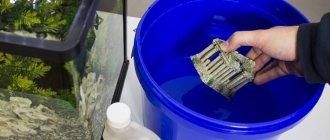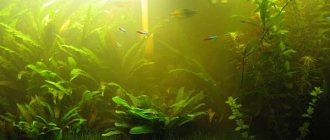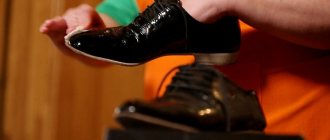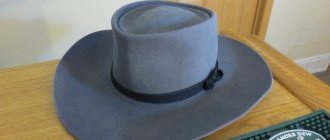An aquarium is not only a magical world of decorative fish, snails and algae, it is an integral part of most modern interiors. And in order for an aquarium to delight its owner with beauty and sophistication for a long time, it is necessary to maintain certain conditions in it with the help of all kinds of compressors and filters, special lighting and a hydraulic supply system. In addition, timely and proper cleaning of the aquarium is a prerequisite for its maintenance.
Why do you need to wash and clean your aquarium?
Due to the vital activity of fish and plants, food residues accumulate at the bottom of the aquarium, the water becomes cloudy, green and white deposits appear on the glass, soil, and decorative elements, and the filter becomes clogged. The resulting plaque indicates an imbalance in the ecosystem caused by the appearance of bacteria. This factor directly affects the fish, affecting their health. The aquarium requires weekly cleaning to ensure a comfortable life for the fish. In a clean aquarium, fish are more active, get sick less and live longer.
Factors influencing pollution
- Aquarium overfilling. There should be at least 1.5–2 liters of water per fish.
- Excess feed. It settles to the bottom and provokes active algae growth. Therefore, food should be poured in moderation.
- Water stagnation. Natural bodies of water clean themselves, but this does not happen in an aquarium. The contents become cloudy and become overgrown with algae.
- Bright light. Due to strong lighting, the water blooms, cloudiness and excessive vegetation appear. The aquarium must be placed away from direct ultraviolet rays. However, do not forget about artificial light. Thanks to the lamps, the water will be clear and the fish will be healthy.
- Size. A small aquarium must be cleaned according to all the rules, like a large one, but more often. Therefore, if space allows, it is better to purchase large tanks.
Preparing and cleaning a new aquarium
Before using an aquarium at home, you need to prepare it for fish or turtles. This is required due to the fact that the aquarium is in a warehouse or store, where dust and dirt have accumulated in it.
Preparation
- Leave the new aquarium open for a few hours at room temperature to remove the silicone odor.
- Leave tap water to stand for several days.
Cleaning
- Place the aquarium in a bathtub or basin, laying something down in advance to prevent scratches.
- Rinse the aquarium inside and out with warm, not too hot, water using a sponge.
- If there are smudges or other contaminants, use baking soda as a detergent or wipe the glass with hydrogen peroxide.
- Rinse the aquarium thoroughly (4-5 times) under strong water pressure.
- Rinse with settled water.
- Leave to dry.
Additionally, wash the aquarium components:
- Special substrates should not be washed, but if the soil is quartz, gravel or sand, then it is washed until the water is clear without using cleaning agents.
- Thoroughly rinse all parts of the new filter under running water without detergents.
- Wash decorative items using baking soda.
The next cleaning is carried out no earlier than in a month. During this time, the fish adapt to new living conditions and biological balance will appear. If the aquarium is maintained properly, the water will become transparent with a yellowish tint.
How often should you clean your aquarium?
You can understand that it’s time to wash the aquarium based on the results of a water test for nitrates and ammonia or based on external factors. If the aquarium is dirty, then you will see with your own eyes mud clouds rising from the substrate, growths on the walls, etc.
The frequency of cleaning the aquarium depends on its volume, the number of fish and plants living in it. On average, the cleaning procedure is performed 1–2 times a week.
How often should you siphon the soil in an aquarium?
The causes of soil contamination are fish waste products and food residues from feeding. Clearing the soil is a labor-intensive process, which is not necessary unless necessary.
The right time for the procedure can be determined by the unpleasant smell of rotten eggs that rose with the help of bubbles when turning the pebbles. The smell is caused by hydrogen sulfide gas, which can make fish sick and, in severe cases, die.
Cleaning should be carried out at least 2 times a month.
How often to wash the external filter in an aquarium
The filter purifies the liquid and accumulates beneficial microorganisms in it, which accumulate on external parts. Frequently washing the filters will destroy the beneficial bacteria necessary for an active and healthy life for your fish. Therefore, cleaning the filter should not be done more than once a month. The components can be replaced or rinsed, depending on the design of the model.
Reasons for the appearance of greenery
Green plaque on the walls causes the development of a number of algae - green euglena, filamentous edogonium and xenococus. These algae envelop not only the walls of the vessel, but also soil stones and decorative elements. The algae development cycle is 3 weeks, during which time all spores settle on the walls of the tank. The green coating begins to lighten, and at this moment it is necessary to get rid of the spores, preventing the start of a new cycle.
The main causes of excessive development of green algae:
- Excessive lighting. The aquarium should not be located directly next to a window under the influence of direct sunlight; artificial lighting must be strictly regulated.
- Insufficient cleaning of glass, soil, plants. Spores lingering in the ground, in scratches on glass, on vegetation, contribute to the further proliferation of algae.
- Incorrect temperature setting.
- Untimely water replacement.
- High concentration of phosphates and nitrates as a result of untimely water replacement. As the liquid evaporates, the amount of salts in it increases; adding water instead of replacing it aggravates the situation.
- Excess food or unsuitable food, uneaten food remains settle to the bottom and begin to rot.
The age of the aquarium must be taken into account. In a new tank, the appearance of algae may be caused by the fact that the nitrogen cycle has not yet been established, or the aquarium plants are not sufficiently rooted. If a green coating appears in an old tank, most likely this is caused by a large amount of organic residues. It is necessary to check whether the filter is clogged. Having determined the causes of the problem, it will be easier for you to choose methods to combat it and remove greens from the aquarium.
How to clean an aquarium
Special means
These are specially developed cleaning products, after use of which you need to completely wash off the remaining particles so as not to harm the inhabitants.
Examples of cleaning products:
- wipes with impregnation to dissolve lime and green deposits;
- spray for cleaning glass from calcification;
- filter softener that reduces the level of hardness, etc.
To use the above products, it is recommended to completely empty the aquarium and, in the case of the latter, to use it for a short period of time.
Folk remedies
In the event that there are no special cleaning products at hand, an alternative replacement with products available on the farm is possible:
- Baking soda is the most famous cleaning agent.
- Vinegar (9%) copes with white plaque. A tablespoon of vinegar per 200 grams of water.
- Wine vinegar will replace glass cleaner. A spoonful of vinegar dissolves in a glass of water, leaves no streaks and quickly removes plaque.
- Citric acid is effective against calcium deposits. 20 grams of powder are diluted in a glass of water.
- Ammonia is also used for decalcification. Diluted in a ratio of 1:10.
- Hydrogen peroxide is another effective option. The substance is diluted in a ratio of 1:15. Peroxide will help in case of rapid spread of algae, filter malfunction, etc. It allows you to saturate the water with oxygen and oxidize the resulting organic matter. The solution is sprayed in a thin stream into the filter, which will gradually release it into the water. After about an hour, the water is changed to remove dead organic matter.
To use liquid solutions, it is most convenient to use spray bottles.
What products are not recommended for cleaning an aquarium?
It is not recommended to use regular glass cleaners as they contain ammonia, which is toxic to fish, as well as regular cleaning agents. As in the case of special and folk remedies, this is caused by the likelihood that residues of the product will remain on the surface. Only in the case of chemicals does this chance increase many times over, since the stronger the chemical, the more difficult it is to wash it off.
Making a scraper with your own hands
The aquarium owner can make a scraper himself using available materials. There are various design schemes suitable for removing light contaminants or a durable layer of deposits. The low cost of a homemade tool allows you to reduce the cost of maintaining an aquarium.
Scraper with magnet
To make a magnetic scraper for an aquarium with your own hands, you will need 2 magnets (rectangular and any configuration), insulating tape and a piece of felt.
Before starting work, the material should be boiled to remove bacteria and increase elasticity. You will also need a plastic card, a roll of fishing line and a sewing kit. A homemade magnetic scraper sinks in water, so cleaning should be done carefully, avoiding the magnet coming off the glass.
Manufacturing algorithm:
- Wrap a rectangular magnet in felt and stitch the material.
- Place a plastic card on the side edge and secure with fishing line. The protruding part will allow you to remove dense deposits from the glass of the aquarium.
- Wrap the outer magnet with insulating tape to protect the surface of the artificial reservoir from damage.
- Check the functionality of the product.
Scraper with plastic card
Manufacturing algorithm:
- Cut out a metal corner and drill 4 holes to secure the handle and working element. The degree of bending of the plate determines the ergonomics of the tool.
- Attach a plastic card (for example, a telephone card or a discount card issued in chain stores). The use of a material with low strength prevents the formation of scratches on surfaces; as wear occurs, the edge is trimmed or another card is installed.
- Fix the handle from a steel knitting needle, the length depends on the depth of the aquarium.
- Check the functionality of the homemade design.
Scraper with blade
You can make a scraper from a sheet of PVC plastic and a fragment of a blade from a stationery knife. Before making a tool, you should decide on the width of the cutting edge and draw the outline of the future product on a PVC sheet. The use of plastic provides positive buoyancy to a homemade device for cleaning aquariums. Several layers of PVC are used for manufacturing, ensuring the rigidity of the scraper. The blade is secured with screws or screws and additionally fixed with epoxy glue.
An alternative method involves using a PVC water pipe and an angle bracket that allows you to secure a safety razor blade. The parts are held by friction; the owner can use handles of different lengths.
Some aquarists install an additional tube 70-80 mm long on the corner, at the end of which they make a slot for installing a blade. Making the tool takes up to 20 minutes.
Scraper with sponge
For production you need:
- Make a support platform from thick plastic.
- Attach the handle at an angle with screws or glue.
- Place a piece of dense foam rubber on an adhesive mixture that is resistant to water.
- Check the functionality of the homemade scraper.
Cleaning equipment
Glass scraper
Scrapers are needed to remove algae and plaque. The correct selection of tools is made taking into account the characteristics of the aquarium.
The most common is the magnetic scraper. It is the most convenient, allows you to collect plaque by swiping along the glass from the outside, and also does not disturb the fish. A significant disadvantage is its high cost and ineffectiveness in removing limescale.
Plaque can be cleaned with a scraper with a metal blade. When working with such scrapers, you need to be careful not to scratch the aquarium or catch the silicone sealant connecting the walls. Some models of scrapers are presented in a combined form with the ability to replace the blade and sponge with each other.
An alternative to scrubbing is the hard side of a kitchen sponge, not soaked in detergents, or special sponges from the pet store that are sure to eliminate the presence of soap and chemical residues. The soft side of the sponge can be used for general wiping. Hard-to-reach places and decor can be cleaned with a stiff-bristled toothbrush. It is undesirable to use metal tools due to the formation of rust and the danger of it getting into the fish’s esophagus.
Siphon
A soil cleaner or siphon is required to clean the substrate without removing it from the container.
There are different types of siphons. Some drain dirty water directly into the sink, eliminating the need to drain into a bucket, while others have an adapter that allows the water to pass through a filter and back into the reservoir. The principle of the siphon allows you to remove large debris, returning small particles through the filter into the aquarium.
Net
The presence of a net is important when completely changing the water in the aquarium for the safe transfer of fish. The size of the net must be appropriate so as not to damage the fins.
Bucket or bowl
A bucket is needed to collect water and debris. The material must be neutral and not form harmful substances. Inert plastic and enamel are recommended.
Additionally, you can purchase tweezers for planting plants and lifting various parts from the bottom.
Types of siphons
Today there are many different types and models of siphons on the shelves of specialty stores. Their operating principle is identical, the difference is in the types of drive, power supply and the availability of additional options. Depending on the type of drive, the devices are:
Electrical. In addition to the standard components in the form of a tube and a glass, this device has a pump that operates from the mains or using batteries. It is with the help of the pump that the waste is collected. All waste goes into a special pocket, and clean liquid is returned back to the aquarium. The device is convenient to use, does not harm plant roots, and has high power. However, there are a number of disadvantages: the device is fragile, requires frequent replacement of batteries, and is expensive.
The electric siphon has a pump for collecting debris from the ground. The mechanical device operates by gravity. It contains a funnel, a hose and a glass. The pressure depends on the width of the hoses and funnel - the narrower they are, the greater the force with which the liquid is suctioned. Many models are equipped with bulbs, with the help of which pumping begins. This siphon is quite easy to use, does not require special skills, is suitable for processing any aquarium, and is accessible to everyone. The disadvantages include the impossibility of adjusting the power of liquid flow and the difficulty of working in places where algae accumulate. In addition, an auxiliary water collection tank is required for subsequent filtration.
Mechanical siphon suitable for all aquariums
How to properly clean an aquarium
Proper cleaning is carried out in compliance with a strict sequence, without which you will not be able to achieve the desired effect. For safety reasons, before starting cleaning, turn off the power to all electrical appliances, except external filters. It is recommended to refrain from feeding the fish 2 hours before washing.
Cleaning the walls
If there is lime or green deposits on the walls, cleaning is done with a special scraper or similar glass cleaners. Draining the water and removing the fish is not necessary (unless sharp blades are used for cleaning). The procedure should be carried out carefully to avoid grains of sand getting on the glass, which could scratch it.
For light contamination, it is enough to wipe the aquarium with a sponge. Pressing the sponge tightly against the glass, you need to move it down to the ground, and then also slowly move it up. After rinsing, repeat the operation until the glass is completely clean.
It is not necessary to remove the algae washed from the walls: some will be eaten by fish, the remainder can be removed when changing the water.
The more regularly the procedure is performed, the thinner the plaque and the easier it is to get rid of it.
Aquarium bottom care
The substrate requires cleaning from excrement and food residues. A siphon pump will help in this matter. It's enough to just walk along the bottom. You should work with the siphon carefully so that fish, plants and soil do not disappear along with the dirt. It is better to choose a white basin for draining, so as not to miss a fish that accidentally gets into the hose. You should start cleaning by moving from the most contaminated places to the cleanest ones.
If sand is used as a substrate, it is better to give preference to a pump hose so that the sand is not sucked in (the pump should be kept at a distance of 2.5 cm from the bottom surface).
Soil without a siphon can be washed by stirring in a bucket under strong pressure of running water, having previously moved the fish to a separate container. The soil is washed until the water becomes clear. It is not recommended to wash the soil if the aquarium is densely populated with algae, as this will damage their root system.
Changing the water in the aquarium
To replace, you will need to remove a third of the total volume of stagnant water so as not to harm the established microflora. The volume of replaced water varies depending on the degree of contamination and the conditions of the aquarium (number of fish, plants, filter power and the fish’s desire for cleanliness). Complete removal of water is carried out in extreme cases.
After the old water has been drained, new, settled or chlorine-filtered water with a temperature close to the temperature of the aquarium is added.
Cleaning the filter
Cleaning the filter cannot be combined with washing the decorations and replacing them with water. A sharp jump in water balance can harm the inhabitants of the aquarium. The filter is unplugged, removed from the aquarium and disassembled. Carefully brush the external filter with a toothbrush so as not to wash away beneficial bacteria. When washing the filter, take out the foam insert and wash it under the pressure of running water.
Do not use detergents or wash in hot water. This will kill any flora that has formed in the filter.
Vegetation treatment
Plants and algae are carefully inspected for defects. If yellowed and rotting leaves are found, then pruning is necessary. When weeding root species, you should not raise bottom mud.
Cleaning gravel, stones and decorative elements
Aquarium decorations also need to be cleaned, since plant spores may be located on their surface. Large pebbles, shells, houses and castles should be taken out and washed under running water. Use a sponge to remove dirt and algae. In case of severe stains, soaking the product for 15 minutes in bleach in a ratio of 9:1 will help. After the bleaching procedure, it is necessary to rinse the cleaned decor with boiling water and rinse well with running water. It is advisable to let it dry thoroughly before returning.
Cleaning the outside of the aquarium
The outside of the aquarium is cleaned using a sponge or cloth moistened with water. All external surfaces of the aquarium are wiped, starting with the lamp and ending with the lid. The glass is washed from drops and fingerprints, and then wiped with a dry cloth.
Review of professional equipment
Today, manufacturers of equipment for aquarium maintenance offer a large selection of siphons for cleaning soil of various types: cheap and expensive, mechanical, electrical, of various capacities, with sedimentation tanks and special valves. It is difficult to decide, at first glance, which device to give preference to. The main thing when choosing is not to rush and determine a specific model that is suitable for a particular case. Popular brands of cleaning equipment:
EHEIM. If the aquarium owner prefers high-tech systems, then he will like the famous German products. The battery-powered electric device weighs 630 g. Despite its light weight, it effectively cleans the aquarium without draining the liquid. He immediately returns the purified water. The suction tube has serrated perforated edges. This is necessary in order to preserve the roots of the plants. This device is designed for containers up to 200 liters, the height of which is no more than 50 cm. The disadvantages of the device include the high cost and rapid discharge of the batteries. The last problem can be solved by installing an adapter so that the power comes from the electrical networks.
The electric siphon from the German company EHEIM is lightweight and efficient. HAGEN is a company from Germany that is a leader in the production of cleaning siphons. The company has an extensive line of its products, the prices of which are not affordable for everyone. The electric device Hagen Marina Aqua Vac carefully and efficiently cleans the soil at the bottom, and also allows you to change the water using a 7-meter hose included with the device. The cost of this device is very high and amounts to about 6 thousand rubles. If purchasing a device is too expensive, you can buy a compact device from this company, which can be launched using a rubber bulb. In addition, to collect liquid you will need a container that needs to be installed below the aquarium. The cost of such a device is no more than 600 rubles. The Tetra company produces siphons of different capacities. Cost varies, but in general these cleaners are budget-friendly and high quality.
AQUAEL. Many experts praise this Polish company. It creates lightweight and effective siphons for the soil in the aquarium. This company has been competing with German companies for a long time. Their big advantage is the low cost of production.
The choice of manufacturer depends on the budget and preferences of the buyer. Cleaning an aquarium is an important procedure for maintaining normal living conditions for its inhabitants. You can buy a special siphon ready-made or make it yourself and save a lot of money.
Previous AquariumSkimmer for an aquarium: the principle of operation of the equipment, how to make a skimmer with your own hands Next Aquarium Turbidity of water in an aquarium with fish: causes and methods of combating
Aquarium disinfection
Disinfection is carried out in case of infection in the aquarium, when simple washing is not enough. The aquarium is filled to the brim with a disinfectant solution for 2 days, thoroughly washed and left to dry for at least a day. The fish should be placed in separate containers with clean water.
It is recommended to use disinfectants such as potassium permanganate, chloramine solution, formaldehyde, diluted hydrochloric and sulfuric acid.
It is recommended to heat treat (boil) the equipment used. All surfaces are treated with a disinfectant solution, including the filter, decorations, lid, etc.
How to restore the biobalance of an aquarium
The method of restoring biobalance depends on the reasons that caused the disturbance.
Causes of biobalance disturbance
- Too many plants.
- Infection.
- Overfeeding.
- Lack or excess of light.
To restore biobalance, the following methods are used:
- Launching cleaner fish.
- Mechanical cleaning.
- Reducing lighting time.
- Complete cleaning of the aquarium.
- Algae control products, etc.
Biological balance is characterized by the transparency of the water, its yellowish color and the natural greenery of the plants.
How to soften the water in an aquarium
Suitable conditions for aquarium plants and fish are a hardness of 4–6 dKH degrees and an acidity of 6.8–7.2 pH. As dKH increases, the basicity of the medium increases (the medium becomes alkaline). This negatively affects the health of living organisms and leads to imbalance. It is also not recommended to reduce the hardness too much, since the water balance is disturbed.
- Boiling is the simplest and most accessible method. Hardness decreases as a result of precipitation of calcium and magnesium salts. The water is boiled, cooled, settled and poured into the aquarium.
- Distillate is a source of soft water. The hardness of this water is 1 dKH, but it is very convenient to dilute hard water. The main thing is to do this carefully so as not to provoke a deficiency of elements.
- Freezing is the incomplete freezing of water followed by thawing. Water hardness after defrosting is 3 dKH.
- Electrolysis is the softening of aquarium water by lowering electrodes. During this procedure, the liquid parameters are brought to 0 dKH.
- Reverse osmosis filters are an expensive method that allows you to obtain water with a parameter of 0–1 dKH.
How to care for a salt water aquarium
- For a saltwater aquarium, proper preparation of seawater is an important component. Simply standing the water will not be enough. Distilled liquid or double purified water is used.
- Using pumps, flow is simulated.
- A weekly partial water change is required.
- The walls and bottom are cleaned once a week.
- Water quality must be monitored regularly.
Otherwise, the care rules are the same as for a freshwater aquarium.
How to clean an aquarium from white limescale deposits
White limescale is the remains of mineral salts deposited on the surface of the glass as a result of evaporation of the liquid.
Methods for cleaning white deposits in an aquarium:
- Mechanical cleaning. Using a scraper, toothbrush, or the hard side of a sponge.
- Special glass cleaning products (sprays and wipes).
- Folk remedies (citric acid, ammonia, etc.).
How the device works
In simple terms, a siphon is a regular pump. In general, it is a device for pumping out liquid. For example, water will be pumped out of an aquarium along with fish waste.
The main part of the tool is presented in the form of a suction tube. The principle of operation of a siphon for aquariums is very simple: one end of the tube is lowered tightly to the ground, and the second is placed as low as possible in relation to the level of the bottom of the aquarium. The outer tip is dipped into a jar or bucket. It is necessary to create a vacuum in the pipe, but this is a fairly simple procedure, similar to pumping gasoline out of a car using a rubber hose. Vacuum is created by sucking air through the mouth. Similar manipulations are carried out to launch a siphon in an aquarium.
The siphon makes cleaning the soil in the aquarium much easier
The liquid along with the waste will flow by gravity into the pipe and drain into a pre-prepared container. As a result, you need to wait until the dirt settles and drain the water back into the aquarium. The process is not particularly difficult. The auxiliary devices of commercial siphons for cleaning aquariums can be considered the result of scientific developments.
https://youtube.com/watch?v=QtjnjLJkLD4
Cleaner fish, snails and other helpers that clean the aquarium
There are biological organisms that prefer to feed on algae, organic debris, and rotten plant leaves. They help clean the aquarium from the inside.
- Cleaner fish (Siamese algae eaters, otocinclus, ancistrus, etc.).
- Algae-eating snails (Helena, Javanese corbicula, porcelain septaria, etc.).
- Algae-eating shrimp (amano, cherry shrimp, neocardines, etc.).
- Catfish (dwarf and brocade catfish, ancistrus), etc.
Adviсe
- Unnecessary manipulations interfere with the life of the inhabitants of the reservoir, so you should only get into it if necessary. 3-4 days before cleaning, reduce the length of daylight in the aquarium (to 6-7 hours) and do not feed the fish on the day of the procedure. Cleaning equipment must be separate for each aquarium.
- Experienced aquarists advise keeping as few snails as possible and as many Ancistrus and Otocinclus as possible. The latter play the role of aquarium cleaners: they move along the walls and do not allow plaque to take hold.
- In addition, to prevent the formation of a limescale film, the filter exhaust should be directed at a slight angle along the front glass to form a constant wave. It also prevents the formation of water stone.











